Repotting snake plants is pretty easy and doesn’t take much time. In this post, I’ll tell you all you need to know, and show you exactly how to do it, step by step.
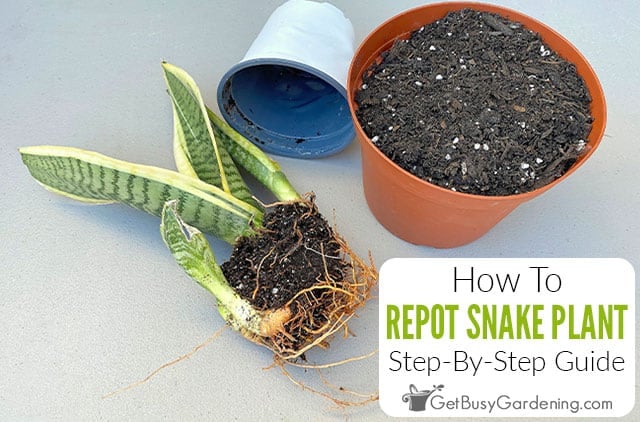
If your snake plant has outgrown or is cracking its container, then it’s time for repotting.
Learning how to repot snake plants (aka mother-in-law’s tongue) is easy, doesn’t require any special skills, and is an important part of their long-term health.
In this step by step guide I’ll show you how to replant them and answer all your questions. With this knowledge, you can keep your Sansevierias rejuvenated and thriving for years to come.
When To Repot A Snake Plant
The best time to repot Sansevieria is during the late winter or early spring. That allows it to settle into its new home and spend the summer putting on new growth.
But if it’s severely root-bound, and you notice it’s struggling later in the year, you can replant it in the summer or fall.

How Do You Know When Your Snake Plant Needs Repotting?
You’ll know your snake plant needs repotting when it’s become severely root-bound.
Roots will start coming out of the drainage holes in the bottom of the pot, or they will bulge, or even crack, their container.
It may be less obvious in sturdier pots though. If a previously happy Sansevieria begins to shrivel, or the water runs straight through the pot, it’s a good sign that they’re out of room.
Here’s the full list of signs that it’s time for a new pot…
- Roots coming out the bottom of the container or above the soil
- Soil won’t hold water, it just runs straight through
- The pot is distorted or cracking
- Container keeps falling over (top heavy)
- Growth has slowed or stopped completely
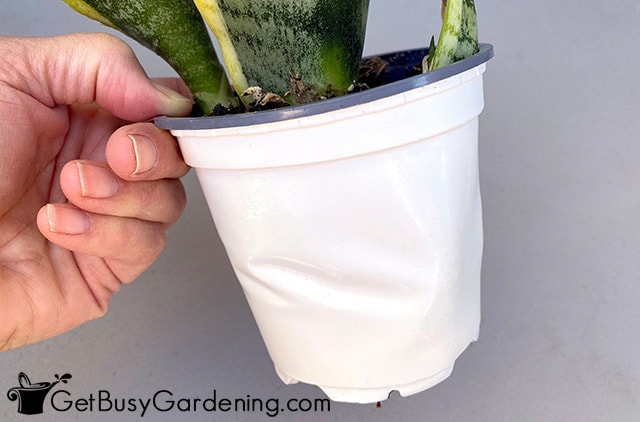
How Often Should I Repot My Sansevieria?
Growth rate and container size will determine how often you need to repot your mother-in-law’s tongue.
In an ideal environment, they may need it every two years or so. But in containers with plenty of room to spread, they might be fine for 4-6 years.
It’s good to remember that snake plants prefer to be slightly pot-bound, so avoid repotting unless they’re in need of more room.

Preparing To Repot A Snake Plant
Before we get into the steps for repotting a snake plant, first let’s chat about the ideal container. Choosing the right pot and soil will help it adjust much faster.
Choosing A New Pot
While they can do very well in a wide variety of containers, it’s ideal to choose one that’s only 1-2” bigger than the current pot.
Too much space can lead to more water retention and increase the risk of root rot. Select one with drainage holes to help prevent that.
They’re top-heavy too. So choose a pot that’s wide rather than tall, and ideally made from a weighted material like ceramic or terracotta to reduce the risk of tipping.
Best Soil For Repotting Snake Plant
The best soil for repotting snake plants is a loamy, aerated, well-draining medium.
You can purchase a quality mix, or try making your own by combining 2 parts potting soil with 1 part of perlite or pumice, and 1 part coarse sand.
Related Post: How To Choose The Best Snake Plant Soil
What To Do After Repotting Sansevieria
Once your snake plant is potted up into its new container, it’s safe to resume normal care.
Keep it in an area with bright, indirect light, and don’t water again until the soil has dried out several inches down.
I recommend you refrain from fertilizing for at least a month while it settles in to help prevent severe transplant shock.
Related Post: How To Propagate Snake Plants In Water Or Soil
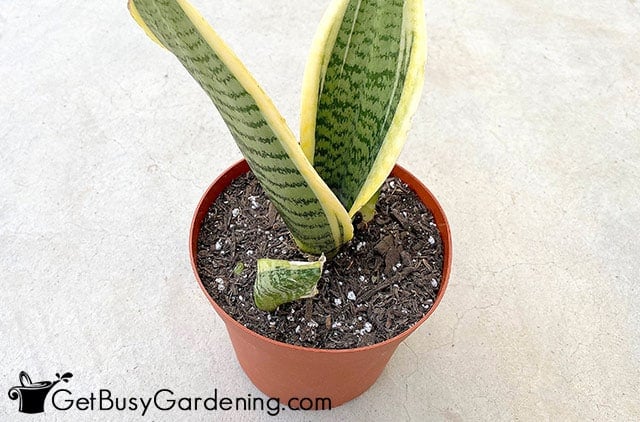
FAQs
Here I’ve answered some of the most commonly asked questions about repotting a Sansevieria. If yours isn’t on the list, please add it to the comments section below.
Do snake plants like to be crowded?
Yes, snake plants do like to be crowded. However when they’re severely root-bound the pot can break, or they can have a hard time absorbing the water and nutrients they need.
Do you water a snake plant after repotting?
Yes, you should water a snake plant after repotting, then wait until the soil has dried at least two inches down before giving it another drink.
Can you plant two snake plants together?
You can plant two snake plants together in a single pot as long as it’s large enough to accommodate their size.
Can you repot a snake plant in fall or winter?
You technically can repot a snake plant in fall or winter. But since it’s entering a rest period, it can cause them to become weak or leggy during the winter. For best results, wait until early spring.
Now that you know how easy it is to repot snake plants, you’ll be able to respond whenever yours have outgrown their pots. Use these tips to keep yours healthy and happy for many, many years.
If you want to learn all there is to know about maintaining healthy indoor plants, then you need my Houseplant Care eBook. It will show you everything you need to know about how to keep every plant in your home thriving. Download your copy now!
More About Houseplant Care
Share your tips for repotting snake plants in the comments section below.
How To Repot A Snake Plant
Repotting Snake Plants: Step By Step Instructions

The good news is that repotting a snake plant isn’t difficult. It takes just a few supplies and a bit of time to replant them into a larger pot.
Materials
- A clean pot
- Potting soil
- Drainage netting (optional)
Instructions
- Partially fill the pot - Place drainage netting over the holes in the pot to prevent the soil from washing out. Then create a base layer of potting soil by filling the bottom of the new container about a third of the way.
- Remove it from the old pot - Place your hand over the top, and flip the whole plant upside down. Then either gently squeeze the pot or slide a hand trowel around the inside to loosen it up. Avoid pulling on the leaves to prevent damage.

- Loosen the roots - Carefully tease apart the roots to break up the circular pattern so they can spread to fill their new container.

- Replant at the same depth - Place the rootball into the new container at the same depth it was in the old one, and fill in around it with fresh soil.

- Gently press down - Remove any air pockets and ensure the Sansevieria is stable by gently pressing the soil around the base. Continue to add more until the pot is full.

- Water thoroughly - Give it a good drink to help it settle in. Make sure to drain off all the excess. Then fill in any holes with more soil, if necessary.
Notes
- Always make sure your snake plant is well hydrated before repotting.
- Never repot a brand new or an unhealthy snake plant.
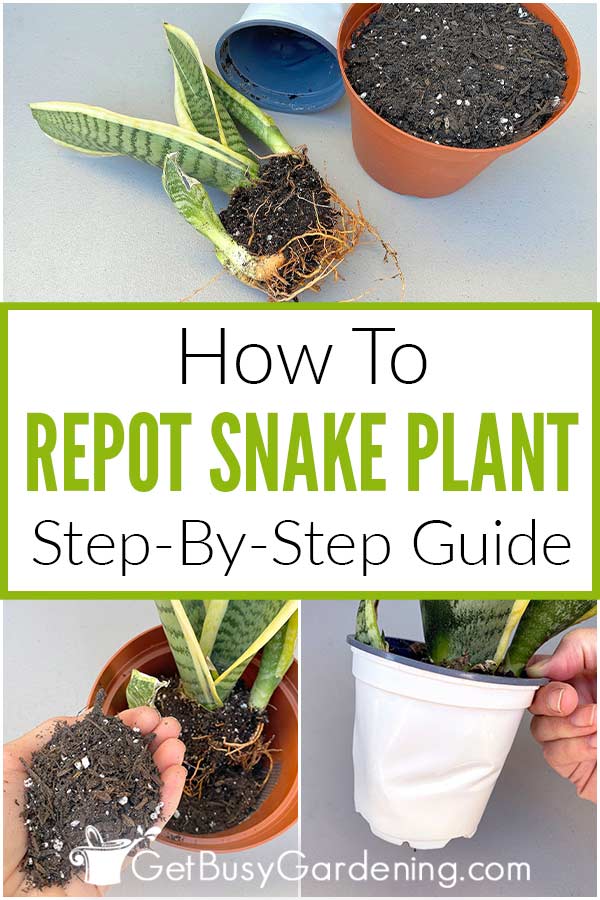
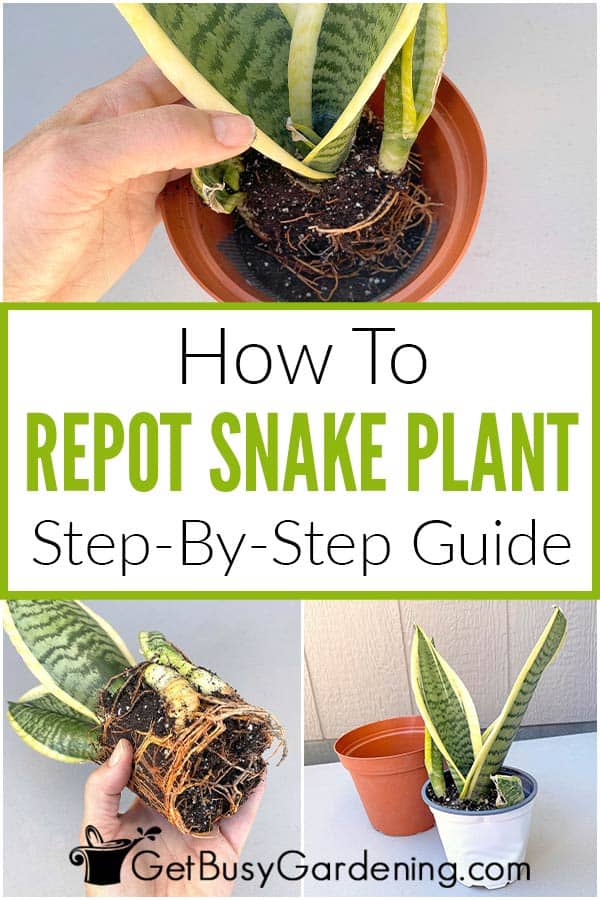
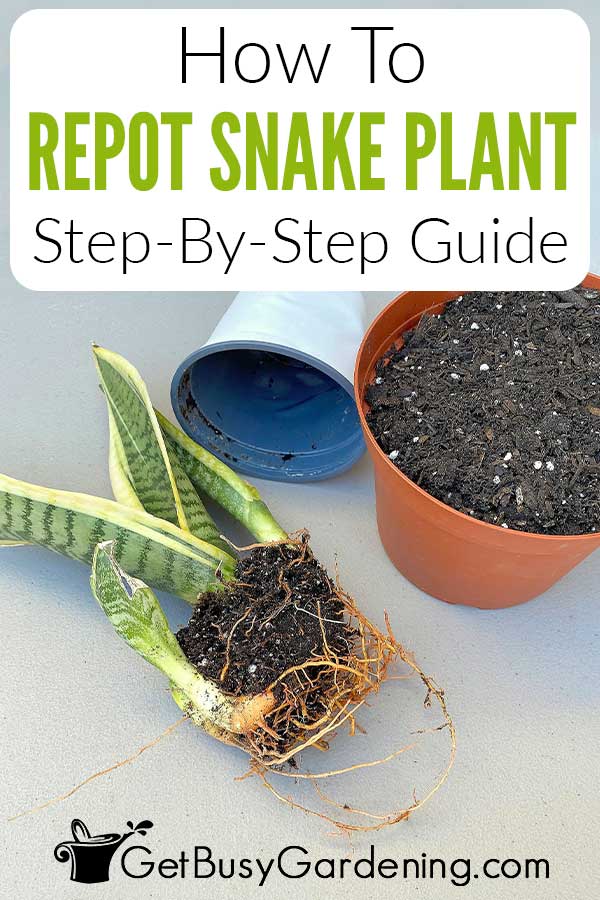


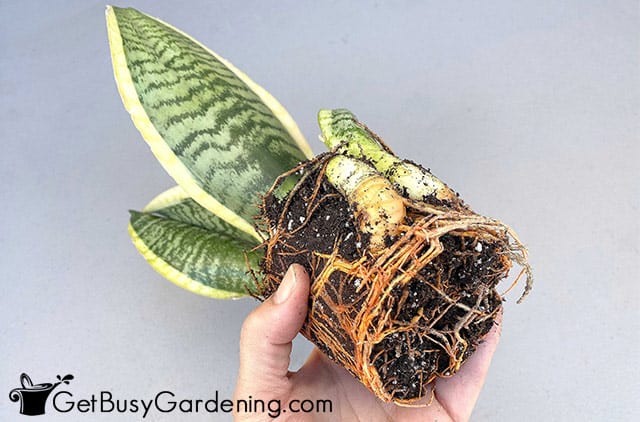
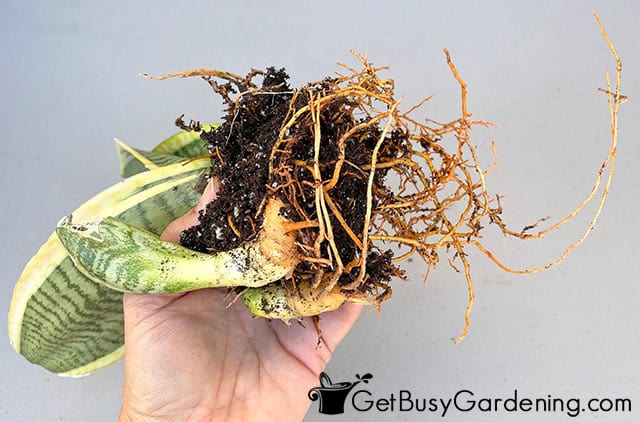
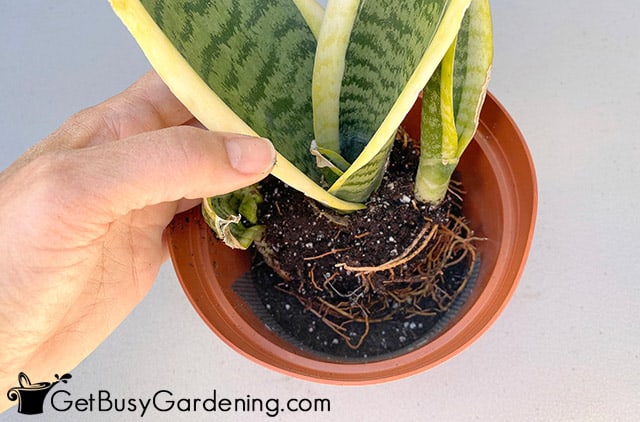
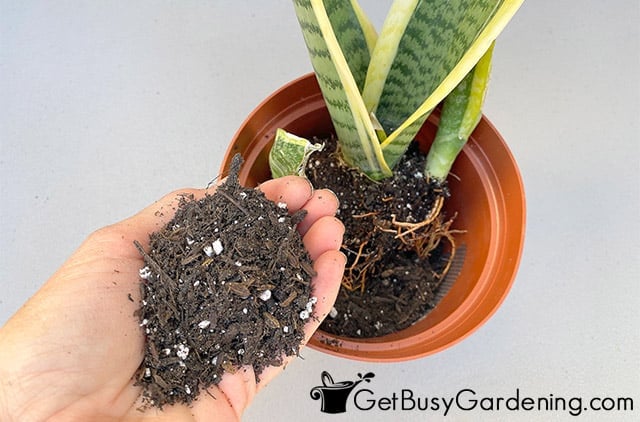

Lahoma says
My snake plant has splits in its leaves. I try not to water it to much but I’m worried. Should I repot it or just leave it alone? The leaves are also leaning a little. Thank you for any advice.
Amy Andrychowicz says
When the leaves split, it’s usually caused by over or under watering. Definitely check the soil. It should dry about 2″ deep before watering again – but it should never be completely bone dry, especially to the point where the soil starts pulling away from the inside of the pot. Check out my full snake plant care guide for more details.
Leta says
My snake plant is about 60 years old. It’s been transplanted once. It’s about 3 feet high. I’m unsure how to safely remove it from the pot it’s in. Can I bury it deeper in the new pot so it’s not as top heavy? There are smaller ones around it. Can they be planted in separate pots? Thank you for anything you can suggest.
Amy Andrychowicz says
It can be tricky to get them out of the pot when they are overly rootbound. If it’s a plastic container that you don’t really care about, you can just cut it off with scissors or a utility knife. But if it’s a pot you care about, then you’ll have to be patient as you work to loosen up your snake plant to get it out. Slide a trowel around the inside of the pot, and carefully loosen up the rootball as you go around. It may take some time, but it will eventually come free. Plant it only deep enough to cover all of the roots, and no deeper. Use a wide/heavy pot to keep it from tipping over. And yes, you can remove and pot up the smaller ones around the mother plant or even split the entire thing if you want.
Lori Smaller says
Hi, I bought a large (10 in pot), very tall snake plant today (early June) in SC zone 8. I would like to transfer to another pot or divide and make two plants. Do I need to wait until winter or early Spring? Thank you in advance. Lori
Amy Andrychowicz says
Summer is also a great time to repot your snake plant, so you can do it anytime. I just don’t recommend doing it in the fall or winter, as it can stress the plant and cause weak, straggly growth.
Deborah Shipe says
I have a snake plant it’s one year old. It’s been doing really good but about two months ago I think I accidentally watered it too much well is there any drying out but it’s starting to sprout returning down I took it to a landscaping place and they re-potted it but she’s so dead really wet and it’s very clumpy and now my leaves my snake plants are starting to fall over. I want to repot it with some new potting soil that you use for succulents but I need to know the proper way to reply replanted I’m very scared to even water it after I replant it because I don’t want it to die, can you help me please thank you
Amy Andrychowicz says
I would definitely not recommend repotting your snake at this point. If the soil is wet, that means it’s beening overwatered, and repotting an already stressed/dying plant will likely end up killing it. The soil should dry out at least 2″ deep or more before you water it again. So do not give it anymore water until the soil has dried out. Then, when you do water, make sure the excess drains completely out of the bottom drainage holes, and never leave it soaking for any length of time. Treat it like you would a succulent plant, and it should eventually recover. This guide will help… How to Water Succulent Plants.
Eve says
My snake plant has fungus gnuts,, can I still repot it? Will repotting help get rid of those flies?
Amy Andrychowicz says
Repotting your snake plant will not get rid of the bugs, and you should only do it when your plant actually needs it, not to try to fix other issues. Here’s how to get rid of the fungus gnats.
Lisa says
The whole plant fell out of the pot it has been in for at least a year. The roots are not very long. How deep
So I plant them in the new pot?
Amy Andrychowicz says
You can repot your snake plant in the same container or use a new one. Since you said the roots aren’t very long, then make sure you use a pot that is not much bigger than the rootball. They like to be pot-bound and can suffer if the container is too large. Plant it deep enough to completely cover the roots.
Joanna M says
Hi there! We stupidly repotted two new large snake plants into self watering cubes. I’ve now read it’s way too big for the plants, but my issue was when we transferred them. The roots came apart almost individually on each leaf.
They are still green three weeks later but so is the one that broke and we didn’t pot.
Have I killed them both?
Amy Andrychowicz says
The roots probably came apart because the snake plant wasn’t established in its (old) pot yet. They’re very slow growing and can live in the same pot for many years. It’s best to allow them to completely outgrown their container before repotting them. Having said that, I would just leave them alone in their new container and make sure they aren’t getting too much water. Eventually they should recover, grow to fill the container, and live in those pots for many years to come. 🙂
Amy Kollman says
If my snake plant is really big should I seperate and make several plants?
Thank you
Amy Andrychowicz says
You certainly can divide your snake plant while repotting it if you’d like, or leave it as a large plant – it’s really up to you.
Janine says
My snake plant has large roots growing out the holes . Should I replant? I feel they are getting squished or damaged on the bottomed.
Amy Andrychowicz says
Yes, when roots are growing out of the drainage holes, that’s a sure sign that it’s time to repot your snake plant.